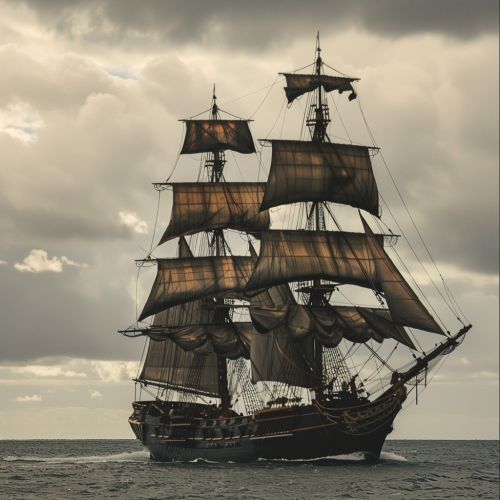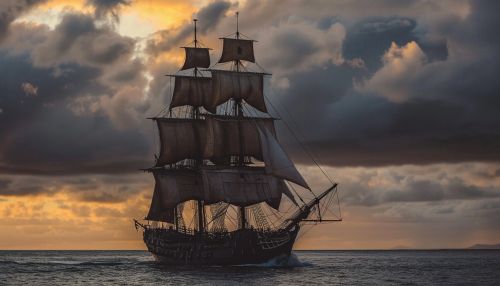Pirates of the Caribbean: The Curse of the Black Pearl
Plot Overview
Pirates of the Caribbean: The Curse of the Black Pearl is a 2003 American fantasy swashbuckler film directed by Gore Verbinski and produced by Jerry Bruckheimer. The screenplay, written by Ted Elliott and Terry Rossio, is based on the Disney theme park ride of the same name. The film stars Johnny Depp, Geoffrey Rush, Orlando Bloom, and Keira Knightley. The story follows pirate Captain Jack Sparrow (Depp) and blacksmith Will Turner (Bloom) as they rescue the kidnapped Elizabeth Swann (Knightley) from the cursed crew of the Black Pearl, captained by Hector Barbossa (Rush).
Development and Production
Concept and Writing
The concept for Pirates of the Caribbean: The Curse of the Black Pearl originated from the Disneyland theme park ride, which opened in 1967. The ride's popularity and the success of other pirate-themed media led Disney executives to explore the idea of a film adaptation. Screenwriters Ted Elliott and Terry Rossio were brought on board to develop the script, which aimed to capture the adventurous spirit of the ride while introducing original characters and plot elements.
Casting
Casting for the film was a meticulous process, with Johnny Depp being the first major actor to join the project. Depp's portrayal of Captain Jack Sparrow was heavily influenced by rock musician Keith Richards, leading to a unique and memorable character. Orlando Bloom was cast as Will Turner, bringing a youthful and heroic presence to the film. Keira Knightley, relatively unknown at the time, was cast as Elizabeth Swann, and Geoffrey Rush was chosen to play the villainous Hector Barbossa.
Filming
Principal photography for Pirates of the Caribbean: The Curse of the Black Pearl began in October 2002 and took place primarily in the Caribbean, with locations including Saint Vincent and the Grenadines and Dominica. The production faced numerous challenges, including inclement weather and logistical difficulties associated with filming on water. Despite these obstacles, the film's crew successfully captured the lush, tropical settings that would become iconic to the series.


Plot Details
Introduction
The film opens with a young Elizabeth Swann discovering a shipwreck and rescuing a young boy, Will Turner. She takes a medallion from him, which later becomes a key plot element. The story then jumps forward several years, where Elizabeth is now the daughter of Governor Weatherby Swann and Will is a blacksmith.
Jack Sparrow's Arrival
Captain Jack Sparrow arrives in Port Royal with the intention of commandeering a ship. His plans are interrupted when the town is attacked by the crew of the Black Pearl, who kidnap Elizabeth. Jack is captured but escapes with Will's help, and the two form an uneasy alliance to rescue Elizabeth.
The Curse
It is revealed that the crew of the Black Pearl is cursed, having stolen cursed Aztec gold. The curse renders them immortal but unable to feel physical sensations. They seek to lift the curse by returning all the gold pieces and offering the blood of the medallion's owner—Elizabeth, who they mistakenly believe is the daughter of pirate Bootstrap Bill Turner.
Climax
The climax of the film takes place on the Isla de Muerta, where a final confrontation occurs between Jack, Will, Elizabeth, and Barbossa. The curse is ultimately lifted when Will, revealed to be Bootstrap Bill's son, returns the last piece of gold and offers his blood. Jack kills Barbossa, and the Black Pearl's crew is freed from the curse.
Resolution
The film concludes with Jack Sparrow escaping execution and reclaiming the Black Pearl, while Will and Elizabeth confess their love for each other. The film ends with Jack sailing into the horizon, setting the stage for future adventures.
Themes and Analysis
Piracy and Freedom
One of the central themes of Pirates of the Caribbean: The Curse of the Black Pearl is the concept of freedom, as embodied by the pirate lifestyle. Jack Sparrow represents a form of personal freedom and nonconformity, contrasting with the rigid societal structures of Port Royal. The film explores the allure and dangers of a life unbound by conventional rules.
Curse and Redemption
The curse of the Black Pearl serves as a metaphor for the consequences of greed and betrayal. The cursed crew's quest for redemption mirrors the personal journeys of the main characters, particularly Will Turner, who seeks to reconcile his pirate heritage with his sense of honor.
Heroism and Identity
The film also delves into themes of heroism and identity. Will Turner's journey from blacksmith to pirate hero reflects his struggle to define himself outside of societal expectations. Similarly, Elizabeth Swann's transformation from a governor's daughter to a pirate ally challenges traditional gender roles and highlights her inner strength.
Reception and Legacy
Critical Reception
Pirates of the Caribbean: The Curse of the Black Pearl received generally positive reviews from critics, who praised its engaging story, visual effects, and Depp's performance. The film was noted for revitalizing the pirate genre, which had been largely dormant in Hollywood. It holds a high rating on review aggregator sites like Rotten Tomatoes and Metacritic.
Box Office Performance
The film was a commercial success, grossing over $654 million worldwide. It became one of the highest-grossing films of 2003 and established a lucrative franchise for Disney. The success of the film led to the production of several sequels, expanding the Pirates of the Caribbean universe.
Awards and Nominations
Pirates of the Caribbean: The Curse of the Black Pearl received numerous awards and nominations. Johnny Depp's performance earned him an Academy Award nomination for Best Actor, and the film was also nominated for Best Makeup, Best Sound Editing, and Best Visual Effects. It won several Saturn Awards, including Best Actor for Depp and Best Costume Design.
Cultural Impact
Influence on Popular Culture
The film has had a significant impact on popular culture, influencing various forms of media, including video games, merchandise, and theme park attractions. Jack Sparrow became an iconic character, and his catchphrases and mannerisms have been widely imitated.
Academic Studies
The film has been the subject of academic studies, particularly in the fields of film studies and cultural studies. Scholars have analyzed its portrayal of piracy, gender roles, and colonialism, as well as its impact on the pirate genre.
Legacy and Future
Pirates of the Caribbean: The Curse of the Black Pearl has left a lasting legacy, both as a standalone film and as the beginning of a successful franchise. Its blend of adventure, humor, and fantasy has set a benchmark for future pirate films and continues to attract new audiences.
